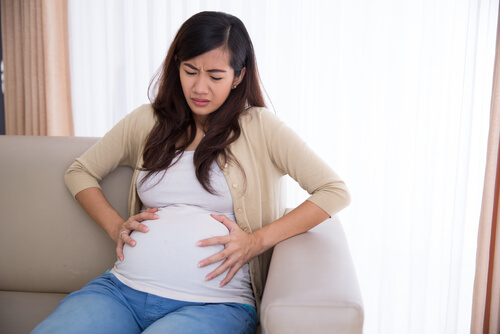Prodromal Labor: What Is It?

Prodromal labor is the term for the first contractions that announce the proximity of childbirth. Your symptoms may last for days or for hours. In addition, each woman experiences them differently.
Preparing the cervix
Prodromal labor is meant to mature the cervix and prepare it for delivery. In this phase, the baby begins to fit its head against the cervix and put pressure on it. This helps to soften the cervix.
A mature cervix feels soft to the touch of the specialist. The more mature the cervix is, the faster dilation will take place.
From week 30, pregnant women experience contractions. These are known as “Braxton Hicks” and their function is to train the uterus for the birth process.
In this phase, you’ll experience a tightening of the belly for a few seconds, accompanied by a slight pressure at the vaginal level.
Unlike prodromal labor, “Braxton Hicks” don’t present pain or discomfort. In some cases, they go unnoticed by women. However, prodromal labor manifests with discomfort.
How to recognize prodromal labor
Prodromal labor is composed of irregular contractions. They don’t have a common pattern or intensity. They can last between 15 and 45 seconds, reaching up to one minute of contractions.
There are many variables that define the symptoms of prodromal labor: the position of the baby, the condition of the mother and the mother’s pain threshold. The discomfort is said to be similar to that of menstrual pain or kidney pain.
Another important factor is that the symptoms may vary from one birth to another. Prodromal labor in first-time mothers manifests differently than in second or third births.
Prodromal contractions vary in intensity. Some may create a lot of pain at first and then dissipate. Others may almost go unnoticed. You may cycle through a wide range of contractions.
The important thing is to be aware of any pattern they follow. Once the contractions become regular, labor has begun. Initial labor contractions occur once every 4 or 5 minutes, approximately.
Prodromal labor usually occurs in the evening or at night. This is the moment in which oxytocin, known as the anti-stress or relaxation hormone, is released in the body.
Some specialists recommend increasing physical activity during this phase. This will help the contractions intensify closer to labor.
What to do during prodromal labor
There is no need to go to the hospital. Especially in the case of first-time mothers, prodromal contractions are often confused with true labor contractions, so the mother immediately goes to the hospital.
It’s important to recognize the symptoms to identify the type of contractions. If the contractions aren’t regular in time and intensity, labor has not begun.
Labor contractions occur every 7, 5 or 3 minutes. Usually they have the same pain index or increase in pain. In addition, they can trigger the expulsion of the mucous plug or break the woman’s water.

Practice breathing. During prodromal labor, practice the breathing techniques you will use during true labor.
If the contraction is weak, abdominal breathing can be used. This helps relax the body and mind.
When the contractions intensify, it is advisable to do chest-level breathing. Air is taken through the nose and the chest is inflated. Then it is expelled through the mouth. This contributes to pain control.
Rest and hydrate
Rest. In view of the fact that prodromal labor is irregular, mothers should take advantage of any time they don’t have contractions in order to rest. This way, the body recovers and energy is recharged.
Some pregnant women prefer to walk or exercise whenever they don’t have contractions. The decision to do this will depend on the level of discomfort or fatigue that the mother presents.
Keep the body hydrated. In certain cases, pregnant women lose their appetites during prodromal labor. It is important to remember that this can last for hours or extend for days, increasing discomfort.
If the mother doesn’t want to eat, that’s fine. However, it’s important for her to stay hydrated. She should consume the recommended amounts of water. She can also be supplemented with infusions or isotonic drinks.
Light meals are recommended during this phase. Heavy digestion increases the mother’s physical discomfort.
Connect with the body. As prodromal labor announces the end of pregnancy, it is important for the mother to prepare herself for the arrival of childbirth.
Maintaining contact with a specialist helps to reduce anxiety.
All cited sources were thoroughly reviewed by our team to ensure their quality, reliability, currency, and validity. The bibliography of this article was considered reliable and of academic or scientific accuracy.
- EL PARTO, C. E. CUIDADOS EN EL PARTO NORMAL: UNA GUÍA PRÁCTICA. http://www.ttiklik.com/wp-content/uploads/2012/03/erditzenaturala.pdf
- Márquez Bustamante, R., & Rodríguez López, R. Cómo disminuir las visitas en Urgencias de las gestantes en falso trabajo de parto. https://congresoenfermeria.com/libros/2016/sala7/5437.pdf
- Rodríguez, C. M., del Fresno Serrano, M. Á., & del Fresno Serrano, E. (2021). Pródromos de parto,¿ Cuándo acudir al hospital?. Revista Sanitaria de Investigación, 2(2), 62. https://dialnet.unirioja.es/servlet/articulo?codigo=7813186
- Silverthorn. Fisiología humana: un enfoque integrado. 2008. Editorial Médica Panamericana. 4ta edición.
- The Rosie Hospital Patient Information. Labor and the latent phase. Cambridge University Hospitals NHS. [Online].
This text is provided for informational purposes only and does not replace consultation with a professional. If in doubt, consult your specialist.
